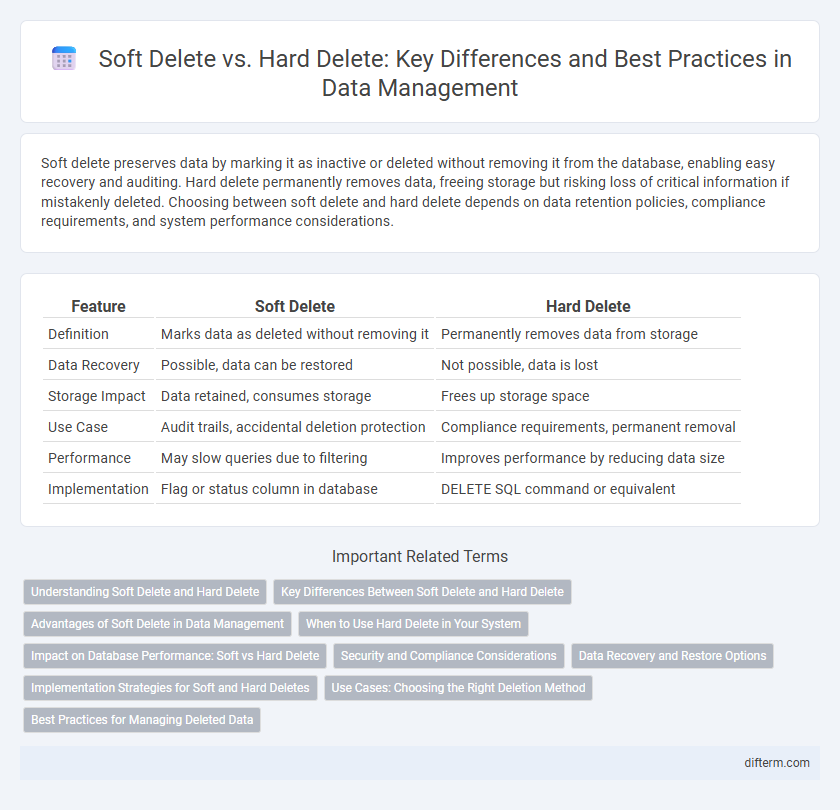Soft delete preserves data by marking it as inactive or deleted without removing it from the database, enabling easy recovery and auditing. Hard delete permanently removes data, freeing storage but risking loss of critical information if mistakenly deleted. Choosing between soft delete and hard delete depends on data retention policies, compliance requirements, and system performance considerations.
Table of Comparison
| Feature | Soft Delete | Hard Delete |
|---|---|---|
| Definition | Marks data as deleted without removing it | Permanently removes data from storage |
| Data Recovery | Possible, data can be restored | Not possible, data is lost |
| Storage Impact | Data retained, consumes storage | Frees up storage space |
| Use Case | Audit trails, accidental deletion protection | Compliance requirements, permanent removal |
| Performance | May slow queries due to filtering | Improves performance by reducing data size |
| Implementation | Flag or status column in database | DELETE SQL command or equivalent |
Understanding Soft Delete and Hard Delete
Soft delete marks data as inactive or archived without removing it from the database, enabling easy recovery and auditing. Hard delete permanently removes data, freeing storage but eliminating any chance of restoration. Choosing between soft delete and hard delete impacts data integrity, compliance, and system performance management.
Key Differences Between Soft Delete and Hard Delete
Soft delete marks data as inactive or hidden without physically removing it from the database, allowing for data recovery and auditing, whereas hard delete permanently removes the data, freeing storage space but eliminating any possibility of restoration. Soft delete typically uses a status flag or deletion timestamp, enabling applications to filter out deleted records while maintaining data integrity. Hard delete improves database performance by reducing data volume but requires careful management to avoid accidental data loss.
Advantages of Soft Delete in Data Management
Soft delete offers significant advantages in data management by preserving data integrity and enabling easy recovery of accidentally deleted records, which enhances overall data resilience. This method allows for auditing and tracking of deleted items, facilitating compliance with data retention policies and regulatory requirements. Implementing soft delete reduces the risk of permanent data loss and supports better decision-making by maintaining historical data for analysis.
When to Use Hard Delete in Your System
Hard delete is essential when compliance regulations require permanent removal of sensitive data, ensuring no recovery is possible. Systems handling confidential information, such as financial records or personal identities, benefit from hard deletes to maintain data privacy and security. Use hard delete when eliminating obsolete or corrupted data that no longer serves operational needs and must be completely purged from the database.
Impact on Database Performance: Soft vs Hard Delete
Soft delete preserves data by marking records as inactive, which can increase database size and slow query performance due to additional filtering requirements. Hard delete permanently removes records, reducing storage demands and speeding up query execution by eliminating the need for filtering deleted entries. Choosing between soft and hard delete impacts database indexing efficiency, backup size, and system responsiveness, with soft delete favoring data recovery and hard delete optimizing performance.
Security and Compliance Considerations
Soft delete enhances data security by retaining deleted records in a recoverable state, supporting compliance requirements for data retention and audit trails, while reducing risks of accidental data loss. Hard delete permanently removes data, which may improve storage efficiency but poses challenges for regulatory compliance and forensic investigations due to the irreversibility of deletion. Organizations must align their deletion policies with industry standards such as GDPR or HIPAA, balancing the need for secure data disposal against retention obligations and potential legal audits.
Data Recovery and Restore Options
Soft delete marks data as inactive or hidden without removing it from storage, enabling straightforward recovery and restoration by simply reversing the flag. Hard delete permanently removes data from the database or storage system, making recovery impossible through conventional means and often requiring specialized data recovery tools or backups. Systems using soft delete benefit from enhanced data retention policies and lower risk of accidental loss, while hard delete commits to immediate data removal for compliance or storage optimization.
Implementation Strategies for Soft and Hard Deletes
Soft delete implementation typically involves flagging records with a status attribute such as "is_deleted" or "deleted_at" timestamp, enabling data recovery and audit trails without physically removing data from the database. Hard delete strategies require direct removal of records from storage using SQL DELETE commands or equivalent APIs, prioritizing data privacy and storage efficiency but eliminating recovery options. Combining soft delete with scheduled hard delete jobs optimizes system performance and compliance by retaining data temporarily before permanent removal.
Use Cases: Choosing the Right Deletion Method
Soft delete is ideal for applications requiring data recovery or audit trails, such as customer relationship management (CRM) systems and content management platforms, where retaining historical data is crucial. Hard delete suits scenarios demanding permanent data removal for compliance or storage optimization, common in financial systems and GDPR-regulated environments. Selecting between soft and hard delete depends on factors like data sensitivity, regulatory requirements, and business continuity needs to balance recoverability with security.
Best Practices for Managing Deleted Data
Best practices for managing deleted data emphasize using soft delete to maintain data integrity and enable recovery, tagging records with deletion timestamps rather than removing them permanently. Hard delete is appropriate for sensitive or compliance-driven data that must be irreversibly removed to meet regulatory standards like GDPR or HIPAA. Combining soft delete with periodic secure hard deletes ensures optimal balance between data retention, system performance, and regulatory compliance.
Soft delete vs Hard delete Infographic

 difterm.com
difterm.com